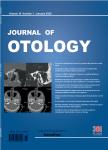ACOUSTIC STARTLE RESPONSE AFFECTED BY AGING AND CHOLINERGIC NEUROTRANSMITTERS
ACOUSTIC STARTLE RESPONSE AFFECTED BY AGING AND CHOLINERGIC NEUROTRANSMITTERS作者机构:Department of Communicative Disorders and SciencesState University of New York at Buffalo137 Cary Hall3435 Main StreetBuffaloNY 14214
出 版 物:《Journal of Otology》 (中华耳科学杂志(英文版))
年 卷 期:2014年第9卷第2期
页 面:73-80页
学科分类:1002[医学-临床医学] 100213[医学-耳鼻咽喉科学] 10[医学]
主 题:startle reflex hyperacusis acetylcholine scopolamine
摘 要:The acoustic startle response has been used to evaluate tinnitus and hyperacusis in animal models. Gap induced prepulse in- hibition of the acoustic startle reflex (gap-PPI) is affected by tinnitus and loudness changes. Since tinnitus and reduced sound tolerance are commonly seen in elderly, we measured gap-PPI in Fischer 344 rats, an aging related hearing loss model, at dif- ferent agcs: 3-5 months, 9-12 months, and 15-17 months. The startle response was induced by three different intensity of sound: 105, 95 and 85 dB SPL. Gap-PPI was induced by different duration of silent gaps from 1 to 100 ms. When thc startle was induced by 105 dB SPL sound intensity, the gap-PPI induced by 50 ms silent gap was significantly lower than those in- duced by 25 or 100 ms duration, showing a "notch" in the gap-PPI function. The "notch" disappeared with the reduction of startle sound, suggesting the "notch" may be related with hyper-sensitivity to loud sound. As the intensity of the stimulus de- creased, the appearance of the hyperacusis-like effect decreased more quickly for the youngest group of rats. We also tested scopolamine, a muscarinic acetylcholine receptor antagonist, and mecamylamine, a nicotinic acetylcholine receptor antago- nist, on the effect of gap-PPI. When scopolamine was administered, the results indicated no addition effect on the hyperacu- sis-like phenomenon in the two older groups. Mecamylamine, the nicotinic antagonist also showed effects on the appearance of hyperacusis on rats in different ages. The information derived from the study will be fundamental for the further research in determining the cause and treatment for hyperacusis.



